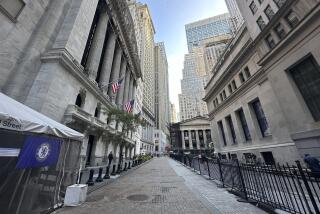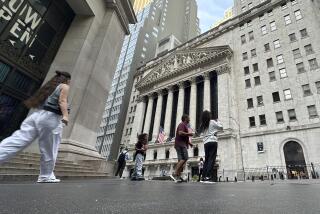Expectation of Higher Interest Rates Sends the Market Into a Tailspin : Economists See a Wide Effect on Consumers but Say Pain Won’t Be Severe
- Share via
The jump in the prime lending rate Wednesday reflected a broad upward movement in interest rates that is affecting the cost of loans for houses, automobiles, appliances and other consumer products, economists said.
“I think we’ll see rate increases in most of the things that are of concern to consumers, like mortgages and auto loans,” predicted Robert H. DeFina, vice president and senior economist at Security Pacific National Bank in Los Angeles.
Those interviewed, however, said the interest rate hikes were not likely to be severe, although they would be widely felt. Allen Sinai, chief economist with Boston Co. Economic Forecasters Inc. in New York, said many loan rates would rise from half a percentage point to a full point by the end of the year.
“I think all the consumer and business loan rates are headed up,” he said. “New borrowers are going to find that loans cost more.”
Just how much more depends on many factors. The particular interest rate for a loan will depend on the lender, whether the loan comes with a fixed interest rate or a rate than can float with changing conditions and other factors.
In general, however, loan rates now are reflecting both the growing fear of inflation, and a change in federal monetary policy. In particular, the Federal Reserve Board is showing its stronger determination to resist inflation by increasing what banks have to pay for their short-term cash needs.
The federal funds rate--the short-term interest rate that commercial banks charge each other for money--leaped this week from 6.75% to 7.125%, reflecting moves by the Federal Reserve to slow down economic activity.
Fears that the economy is overheating have risen dramatically with recent reports of strong economic activity, including the government’s finding that unemployment was at its lowest level in years.
The increase in the prime rate “is a confirmation of what’s been happening,” rather than a cause, said John Tuccillo, chief economist with the National Assn. of Realtors in Washington. Tuccillo said interest rates charged for fixed-rate, 30-year mortgages might rise a quarter of a point in the next couple of weeks. The rate has been hovering between 10.5% and 11% recently. “And then they’ll move gradually upward between late June and the end of the year.”
Certain kinds of consumer loans, particularly those with floating or adjustable rates, are often keyed to the fed funds rate and other short-term rates. As a result, the interest rates for these consumer loans also are being pressured upward.
Although home mortgages are the most commonly known form of adjustable-rate loan, banks increasingly are using adjustable rates for a variety of other loans: “There even are car loans with variable rates, boat loans with variable rates,” said Harold C. Nathan, vice president and senior financial economist with Wells Fargo Bank in San Francisco.
In addition, unsecured personal credit may be pegged to the sorts of short-term rates that have been rising along with inflationary fears. “I wouldn’t be surprised if you see increases in those kinds of personal credit,” said Michael Penzer, a vice president and senior economist at Bank of America in San Francisco.
He added: “People who need to borrow money for an automobile, a piece of furniture or an appliance can expect that those kinds of things are going to go up.”
Why? “Creditors are unwilling to extend that much credit without being rewarded for it,” explained Tuccillo.
Expects Some Increase
In a climate where lenders fear inflation, loans that have nothing to do with the prime lending rate also are affected. Long-term, fixed-rate mortgages are rising, for example, because bond market yields have been rising in anticipation of inflation.
Larry J. Kimbell, director of business forecasting at UCLA, said he now expects interest rates to rise somewhat, because of signs that the economy has been heating up. But he said that too great a rise would hurt the construction industry and threaten the economic expansion.
“Is it really such a good thing to have a booming economy?” he asked.
But Sinai maintained that the pace of interest rate hikes would be merely “annoying.”
“The increases won’t be steep enough to create a recession, but certainly they’ll make consumers think twice about spending and borrowing.”
Prime rate hits 9%, Part I, Page 1
PRIME RATE’S PATH he following are the changes in the prime lending rate by major banks since the beginning of 1986, when the prime stood at 9.5%:
Date Rate 1986 March 7 9.0% April 21 8.5% July 11 8.0% Aug. 26 7.5% 1987 March 31 7.75% May 1 8.0% May 15 8.25% Sept. 4 8.75% Oct. 7 9.25% Oct. 22 9.0% Nov. 2 8.75% 1988 Feb. 2 8.5% May 11 9.0%
More to Read
Inside the business of entertainment
The Wide Shot brings you news, analysis and insights on everything from streaming wars to production — and what it all means for the future.
You may occasionally receive promotional content from the Los Angeles Times.










